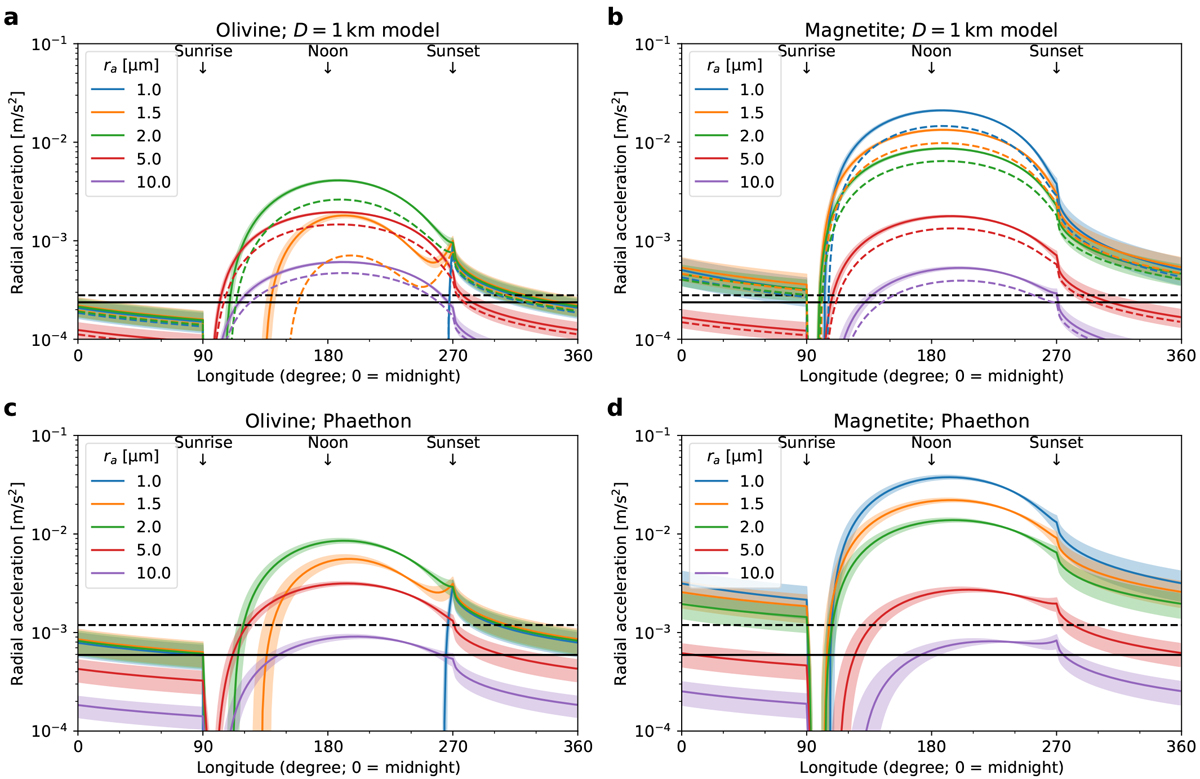Fig. 5

Download original image
Radial accelerations on the equatorial surface at heights of H = 1 cm, for the corresponding particle radius ra with respect to longitude. The net radial radiative accelerations (![]() ) are shown.The black horizontal lines show the gravity and the effective gravity as in Fig. 4. a, c) olivine; b, d) magnetite. Panels a and b are calculated for fiducial perpendicular (solid) and aspect 45° (dashed) model asteroids (D = 1 km) at the heliocentric distance rh = 0.2 au for given particle radii ra in the legend. For the perpendicular model, the 25% ambiguity inthe thermal inertia (Γ = 200 ± 50 tiu) is expressed as shading. Panels c and d are calculated for Phaethon using the nominal physical parameter values (Table 1) at the perihelion. The shading signifies the uncertainty range in the thermal inertia (Γ = 600 ± 200 tiu, Hanuš et al. 2018) of Phaethon. From these figures, it is obvious that most of ≲ 10μm-sized particles areaccelerated outwards from the AR.
) are shown.The black horizontal lines show the gravity and the effective gravity as in Fig. 4. a, c) olivine; b, d) magnetite. Panels a and b are calculated for fiducial perpendicular (solid) and aspect 45° (dashed) model asteroids (D = 1 km) at the heliocentric distance rh = 0.2 au for given particle radii ra in the legend. For the perpendicular model, the 25% ambiguity inthe thermal inertia (Γ = 200 ± 50 tiu) is expressed as shading. Panels c and d are calculated for Phaethon using the nominal physical parameter values (Table 1) at the perihelion. The shading signifies the uncertainty range in the thermal inertia (Γ = 600 ± 200 tiu, Hanuš et al. 2018) of Phaethon. From these figures, it is obvious that most of ≲ 10μm-sized particles areaccelerated outwards from the AR.
Current usage metrics show cumulative count of Article Views (full-text article views including HTML views, PDF and ePub downloads, according to the available data) and Abstracts Views on Vision4Press platform.
Data correspond to usage on the plateform after 2015. The current usage metrics is available 48-96 hours after online publication and is updated daily on week days.
Initial download of the metrics may take a while.


